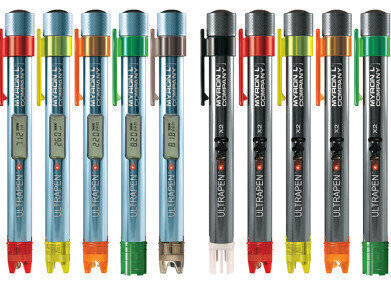Water/Wastewater
Optical Dissolved Oxygen Technology Outperforms Traditional Methods
Sep 24 2009
Three methods are generally used to measure dissolved oxygen (DO) in surface waters: Winkler titration, membrane-covered electrochemical sensors (polarographic or galvanic cell), and optical-based sensors. The optical technology for measuring DO levels in water has quickly become a well-accepted method due to many advantages over membrane sensors, and its close correlation to Winkler titrations.
Optical DO sensors rely on lifetime-based luminescence technology to accurately measure DO levels insitu. If an oxygen-specific lumiphore is illuminated with a blue LED, it causes the lumiphore molecules embedded in the gas-permeable sensing foil to emit red photons. DO acts as a dynamic luminescence quencher, therefore the lifetime of luminescence is inversely proportional to the DO concentration. Optical sensors are especially accurate below 2 ppm—a range in which most membrane sensors routinely give poor results. When monitoring anoxia in open bodies of water, achieving accurate readings below 2 ppm allows researchers to reliably characterise nutrient-related hypoxic zones. Optical DO sensors do not consume oxygen as part of an electrochemical reaction, and do not require sample flow for accurate readings.
Optical sensing technology has been proven in multiple field studies to give accurate data over long deployment periods—with minimal maintenance and calibration requirements. Maintenance and material costs are drastically reduced, and site visits are minimised. Data is especially accurate in anoxic conditions with accuracy in normal environmental DO ranges as good or better than traditional membrane sensors. Additionally, sensor response time is faster, and the sensing element is more durable and has a longer operational life than an oxygen permeable membrane.
According to the American Society for Testing and Materials (ASTM) International, the luminescence-based DO sensor method (D888-05, Test Method C) is an acceptable method for measuring DO. For more information on optical DO technology and on robust, accurate RDO® sensors for groundwater, surface water, and process applications, please visit www.in-situ.com
Digital Edition
IET 34.2 March 2024
April 2024
Gas Detection - Biogas batch fermentation system for laboratory use with automatic gas analysis in real time Water/Wastewater - Upcycling sensors for sustainable nature management - Prist...
View all digital editions
Events
May 20 2024 Columbus, OH, USA
May 21 2024 Lagos, Nigeria
May 23 2024 Beijing, China
May 23 2024 Beijing, China
May 29 2024 Beijing, China



















